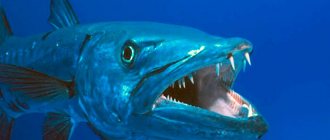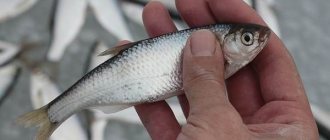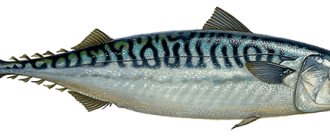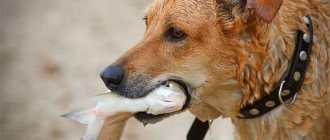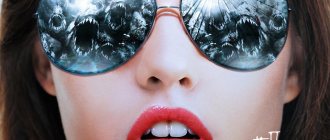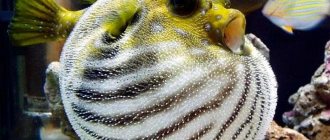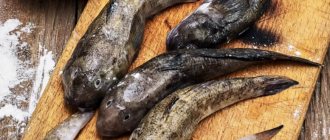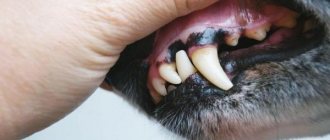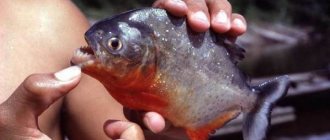The blobfish, the Australian goby or psychrolute (from the scientific name Psychrolutes marcidus), has become widely known as the hero of Internet memes. This is the saddest fish in the world, whose comical but cute appearance is complemented by a drooping “nose”. With the expression of its muzzle and the general amorphousness of its body, this sea creature resembles another hero of the meme, Zhdun. But, unlike him, the drop fish is a real inhabitant of our planet, which is also in danger of complete extinction.
Do you like unusual fish?
- Yes 81%, 1826 votes
1826 votes 81%1826 votes - 81% of all votes
- No 16%, 362 votes
362 votes 16%
362 votes - 16% of all votes
- I don't eat fish 3%, 75 votes
75 votes 3%
75 votes - 3% of all votes
Total votes: 2263
27.07.2020
- Yes 81%, 1826 votes
1826 votes 81%1826 votes - 81% of all votes
- No 16%, 362 votes
362 votes 16%
362 votes - 16% of all votes
- I don't eat fish 3%, 75 votes
75 votes 3%
75 votes - 3% of all votes
Total votes: 2263
27.07.2020
×
You or from your IP have already voted.
Where is it found?
The drop fish lives off the coast of Australia, Tasmania and New Zealand, but it is impossible for humans to meet it in nature. The depth of its habitat is 600-1200 meters, and scuba diving at 40-50 m is already considered deep-sea. Record diving, which required special equipment, the selection of special gas mixtures and many hours of ascent, allowed a person with scuba gear to reach a depth of 332 m. This was done by the Egyptian Ahmed Gabr in 2014.
The worlds of humans and deep-sea fish do not intersect: we cannot live at the pressure native to the drop fish, and she cannot live at ours. The sudden pressure drop when bringing the fish to the surface kills it and significantly changes its appearance.
The Australian goby needs cold water, 6-7 degrees Celsius. They need the seabed to reproduce and feed. These conditions limit the habitat of psychrolutes, and warming of the world's oceans may threaten the survival of the species.
Unlike other cold-loving bottom predators - flounder and halibut - the psycholute does not lie on the bottom, but floats in the water column, so its body has not deformed. But these species compete little with each other; their feeding methods are somewhat different. They dig through the silt and extract crustaceans and mollusks that live in its depth. The food of drop fish is free-swimming crustaceans.
Flounder live in much shallower waters, going down to only 55 meters. Halibuts are deeper-sea, they live and breed at a depth of 300-1200 meters.
Meaning in nature
Australian gobies provide food competition to some demersal fish of commercial importance (for example, flounder). They also eat eggs and young fish of other fish species.
At the same time, drops are important for maintaining species balance in nature, taking their place in the food chain: they are prey for predators living in the depths, and dead fish serve as food for organisms living at the bottom.
DOBERMAN
Related species
The Australian goby is not alone; there are 10 more species in the psycholute family to which it belongs. These are all deep-sea fish that prefer to live in cold waters. This habit gave the family its name: from Greek “psychros” is translated as “cold”. Their common features are a poorly developed pelvic fin and a bare, scaleless body. Other representatives of the psycholute family are found in the Atlantic and Pacific oceans, both in the southern and northern parts, avoiding the equatorial and tropical zones. They live, depending on the species, at depths from 150 to 1000 m.
Varieties
Researchers distinguish two subspecies of blobfish:
- Psychrolutes marcidus . The average size of adult individuals is quite small in comparison with other inhabitants of the seas and oceans: body length usually does not exceed 25-30 cm, while the fish weighs no more than 2 kg. Habitat depth - 1000 m.
- Psychrolutes phrictus . A larger type of drop. The body length of the fish reaches 60-70 cm, and the weight is 8-10 kg. It is believed that these deep-sea inhabitants of the northern waters of the Pacific Ocean are capable of descending to depths of 2800-3000 m.
Appearance
The caught creature looks like a brown or pink droplet without scales, consisting of jelly. Body length rarely exceeds 30 cm, weight up to 2 kg.
The head is in the shape of a flattened ball; from the head to the tail the body narrows, forming a drop. The eyes are small and widely spaced.
There is no swim bladder: at great depths it is ineffective; gas from it would escape due to the high environmental pressure. Therefore, the function of the bubble is performed by the entire body of the psycholute. The gelatinous mass of which it consists is slightly lighter than water, and this allows the fish to move without expending energy. This adaptation allows the fish to exist in conditions of high pressure and small amounts of food.
If you suddenly release the pressure on a liquid, it will expand. In physics lessons we were told that liquids are incompressible. This is not entirely true. They compress, just weaker than gases, but stronger than solids. And, once in conditions of normal pressure, they acquire the same volume. At its native depth, the droplet fish is subject to pressure of 60-120 atmospheres. That’s why she looks much more graceful there and doesn’t have such a sad face at all.
A change in pressure will not change the length of the fish, but the soft tissues will certainly be deformed. This is how the “nose” and other amorphous features arise. By the way, one of the first specimens caught and studied, named “Mr. Blobby”, depicted in the most famous photo of the blob fish, lost its “nose” after being fixed in formaldehyde. This substance not only preserves biological tissues, but also dehydrates them. As a result, the specimen, as seen in another photo of it, looks a little more like an ordinary fish.
Underwater, a living psycholute is not at all like the description of a dull fish. He resembles an ordinary bull. His face has nothing in common with the sad appearance we are used to. His mouth is really large, with thick lips (although not as thick as we are used to seeing in pictures).
The drop fish has an almost complete set of fins: pectoral, dorsal, anal and caudal. It is difficult to notice them in caught fish, but they are there. If a drop of fish lived in the upper layers of water, it could be seen swimming quickly, but in deep conditions, with the help of fins, the psychrolute can rather maintain its position than purposefully move somewhere. The pelvic fin is poorly developed, the first and second dorsal fins are fused together.
Lifestyle
Information about the drop fish has so far been collected in small quantities due to the fact that its habitat is very deep. Studying creatures under such pressures, where a person cannot live even a few seconds without special protection, is currently practically impossible.
It is known that the drop leads a measured lifestyle. It lives near the bottom and swims only under the influence of water currents. At enormous depths there reigns darkness and impenetrable darkness. The eyes of the blobfish living in such conditions are adapted to the darkness. She has keen eyesight and is able to see food.
Fish can only rise to a height of less than 600 m if they find themselves in a fishing net.
Where does the drop fish live?
The distribution area of the fish, according to scientists, is the Pacific, Atlantic and Indian oceans.
Most often it swims in the waters near the Australian continent and the island of Tasmania.
The blobfish is accustomed to conditions at great depths. She feels comfortable, despite the fact that the pressure at the bottom is 80 times greater than on the surface of the land.
The comfortable depth for fish to live is on average 600-1500 m. It rarely appears on the shore and only in dead form.
What does it eat?
The saddest fish moves slowly. Due to the lack of muscles, she cannot chase her prey, although she sees it perfectly. Usually the creature either sits on the bottom, opens its mouth and waits, or swims with the current with its mouth open and swallows everything it comes across.
The usual food for blobfish are small invertebrate animals. She actively eats plankton in the quantities in which it enters her mouth from the water.
Sad fish are often malnourished. The reason for this is their measured lifestyle, lack of muscle mass and the small number of inhabitants at such a large depth.
Character and behavior
The behavior of fish underwater remains a mystery to scientists. It is impossible to study the exact character of a sad creature without special equipment.
It is believed that the drop fish behaves secretly in the water. She rarely gets caught in fishing nets. The creature's aggressive behavior was not established even in cases of imminent danger.
The likelihood of a person meeting this creature is close to zero.
Social structure
Sea inhabitants show signs of loners. They do not flock and react calmly to the absence of other individuals nearby. Drops do not feel danger when alone, as they are accustomed to it due to the small population of living creatures on the deep-sea bottom.
During the breeding season, the “brat” pairs up for a short period of time. As soon as fertilization occurs, the fish immediately swim away in different directions. They do not have to fight for territory, since the possessions of a small population have huge areas.
Psycholutes prefer to swim for a long time in their favorite place. They do not leave their usual home, even if it seems less promising in terms of food.
What does it eat?
The Australian goby is a predator, unlike most benthic inhabitants that feed on carrion. The main part of the diet of drop fish is small marine invertebrates drifting in the bottom areas. This fish is a passive hunter; it does not swim after prey, but stays in one place. Australian gobies eat the plankton that floats into their mouths.
An important problem with psychrolutes is that at depth there is not as much life, and therefore food, as in the upper layers of the ocean. The fish itself is not very well adapted to moving long distances for food, which means that if it is unlucky, it may be in danger of starvation.
What does it look like
The psycholute is recognized as one of the most bizarre studied creatures on Earth. The blob fish, whose appearance is the subject of jokes on the Internet, is very popular. For some people, the appearance of an inhabitant of the great depths is frightening and repulsive, for others the picture with a fish makes them laugh, and for others they feel sorry for it.
The body length of a drop fish averages from 30 to 70 cm. The weight of the creature can reach from 2 to 10-12 kg. There were also individual individuals weighing up to 15 kg. Blobfish colors range from light to dark shades of pink and brown.
The head of the psycholute smoothly transitions into the body. In profile, the sad fish looks ordinary and unremarkable, but in full view its appearance is truly amazing. On the front part of the sea creature there is a process that is often compared to a human nose.
The fish's head has saggy "cheeks" and large lips that create a frowning appearance.
The dull fish has no scales on its body. Also, unlike many sea animals, the blob does not have a swim bladder. At the enormous depths where it lives, it would burst, unable to cope with the strong pressure. To adapt to the conditions, the fish has a jelly-like body consisting of a fatty substance that is significantly less dense than water. The fish stays afloat without wasting energy.
Compared to other sea creatures living at great depths, the “drop” seems very small.
The distinctive features of the drop fish include the fact that when it appears at shallow depths or even on the shore, it greatly changes its appearance. She becomes sad and ugly when she is caught. But in near-bottom conditions at great depths, the body looks like a large goby.
Character and lifestyle
Having practically no muscles, a drop of fish in the water can either not move at all, or drift with bottom currents. Her vision is adapted to her habitat: although the photometer records the sun's rays to a depth of 1,000 meters, the human eye can no longer distinguish light below 600 m; everything around us would seem equally black. And the drop fish manages to navigate in such conditions with the help of vision. In natural conditions, her eyes look completely different from those in terrestrial photographs. They protrude above the surface of the head and protrude slightly forward.
Photos of blob fish
A few pictures of the blob fish give you an idea of what it looks like. Below are photographs of creatures that were caught in fishermen's nets.
Reproduction and lifespan
Representatives of this species live 5-14 years, on average 8-9. Little is known about how psychrolutes reproduce: the great depth makes it difficult to observe the fish. Therefore, we do not know what their mating rituals are, how the choice of a partner and mating itself occur. However, it turned out that one thing can be learned: drop fish are caring mothers. They lay eggs in the sand, and then protect the clutch and hatched larvae until they turn into full-fledged fry and are able to escape from predators themselves.
The protection of clutches is often found in deep-sea fish, but care for the hatched offspring is not particularly characteristic even for them. An interesting feature is that the Australian goby takes its droplet-like larvae immediately after hatching to even greater depths, to the quietest places possible. This minimizes the likelihood of early encounters between offspring and predators or scavengers, who, on occasion, will not refuse to snack on the fry.
Even such a device, which provides the brood with maximum survival, cannot significantly accelerate the growth rate of the drop fish population. With the same care of females for their cubs, to double the population in the event of a complete cessation of human intervention in the life of psychrolutes, it will take from 4.5 to 14 years for the number of representatives of the species to double. This is a long time for such a process.
Population and species status
Experts believe that the number of these amazing fish is constantly decreasing, despite the absence of natural enemies. This happens for a number of reasons:
- Expanding the technical capabilities of fishing, so drop fish are increasingly caught in the nets of fishermen, along with crabs and lobsters.
- Constant pollution of the ocean floor with various wastes.
- In some Asian countries, drop fish meat is considered a delicacy, which also has a negative impact on the population of this unique and amazing fish.
The problem also lies in the fact that the number of drop fish is increasing very slowly. For the number to double, it takes at least 5 years, and then only if this process is not interfered with by any factors that could reduce the population.
It is important to know! Today, although slowly, the number of this fish is constantly decreasing due to the fact that the fish are constantly caught in fishing nets, although it is prohibited to catch this fish. Despite the ban, it is still caught, because in some Asian countries it is considered a delicacy and is called king fish.
It is not known what can save the drop, except perhaps its fame in the media. Despite the fact that the fish has been little studied, it has already become popular, starring in several films. More and more voices are beginning to be heard in favor of protecting this amazing fish, otherwise it may simply disappear, although a similar fate awaits many species of flora and fauna.
And although the drop fish does not have an entirely attractive appearance, it is a truly amazing creature that lives on our Planet in the depths of the oceans. Unfortunately, it is quite difficult for science to fully study this species, since the fish lives at considerable depths, where a person cannot go down without special equipment. It is possible that a little more time will pass and all the mysteries of this inhabitant of the depths will be solved.
Main Enemies
According to modern scientists, the Australian bull has no natural enemies. Theoretically, these could include deep-sea squid, angler fish and other predatory inhabitants of the seabed, but whether this is so, as well as what tactics the psychrolute uses to protect itself from predators, is not known for certain. But it is clear that the population of these inhabitants of the depths is rapidly declining.
This is due to humans, or more precisely, to the bottom fishing of marine crustaceans - lobsters and crabs. Along with the delicacy, a strange, sedentary fish also ends up in the net. Thus, a person casually destroys a species that is edible only conditionally and has no other economic value: after trawling, there is no point in releasing fish into the sea that have received injuries incompatible with life due to a rapid change in pressure. Even if it is alive at the time of catching, death after such exposure is inevitable.
Edible or not
The fish is not poisonous, in principle you can eat it, but it has practically no muscles: the body consists mainly of a jelly-like fat mass. It is served only in establishments for exotic lovers. Dishes made from it are expensive, but what is valuable in them is not the nutrients, but the fact of eating such an unusual creature. Chefs prefer to keep recipes for exotic dishes secret. Europeans almost never eat “gelatinous” fish.
How long do blob fish live?
The average lifespan of a drop is 8 years. The period of existence of deep-sea inhabitants directly depends on luck. She has few enemies in nature, has the opportunity to receive food and has a low probability of getting caught in a net.
If the fish actively feeds and prefers swimming in secluded places, then it can live up to 14 years.
The main sources of threat to the life of fish with a sad face:
- fisheries development;
- environmental pollution, in particular oceans and seas;
- large predators;
- lack of nutrition and prolonged fasting.
Security status
Ecologists do not know how much the Australian goby needs protection. Scientists have not been able to calculate how many of these fish now live in the World Ocean, since deep-sea inhabitants are extremely difficult to study. But the genetic diversity of the caught individuals turned out to be small, which means that there is inbreeding within the species. This leads oceanologists to believe that the species is already rare, and threats from trawl fishing for crustaceans off the coast of Australia and New Zealand, as well as warming of the world's oceans, can lead to the fact that the drop fish will remain only in photographs.
You shouldn’t scour the Internet looking for recipes for drop fish dishes. For Europeans it is too exotic, for nature lovers it is rare. It’s also difficult to admire this sea creature - he may be cute, but he’s not handsome. Therefore, the best thing humanity can do for the Australian bull is not to touch it. He made his contribution to art, ecology and even the meme, and deserved to be left alone.
Is it eaten?
The generally accepted opinion is that you don’t eat a drop of fish. European gourmets are indifferent to it. Not a single restaurant has it on the menu. And this is quite natural - the way a dull fish looks causes strong hostility among many. And fresh transportation can be very difficult. But in Japan, China, and a number of Asian countries it is very popular. Dishes prepared from the drop according to a unique recipe are expensive and are rarely served. The fish are not caught purposefully, and therefore only accidentally caught fish end up on the restaurant table.
It is unknown how tasty such a delicacy is, and what caused the interest in it. After all, given the very meager nutrition and the absence of muscle tissue as such, its “meat” can hardly be called useful. The demand is due to the unusual appearance and rarity of the species. But the problem is that it is extremely difficult to catch live fish. Significant changes in pressure and temperature are detrimental to a deep-sea creature. Therefore, before trying a drop in restaurants, you should still think about how fresh it was.
Yandex pictures
Interesting Facts
The drop fish was first caught almost 100 years ago, in 1926. She accidentally fell into the nets of Tasmanian fishermen. Then the unusual find was described, the species was given a name, and the study stopped there. Only at the end of the 20th century did psycholute again attract the attention of researchers: thanks to the development of technology, the study of deep-sea fish became somewhat easier.
The unusual appearance of the drop fish has repeatedly attracted the attention of film directors. It appears in The X-Files (episode "Rm9sbG93ZXJz", season 11, episode 7), where it is served to Mulder uncut in a robotic sushi bar. In the film “Men in Black 3,” the chef presented this creature as earthly, but no one believed him: the gelatinous creature with a sad, human-like face bears little resemblance to ordinary representatives of our fauna.
Internet users have repeatedly voted the Australian bull the ugliest animal on the planet. She even won over pubic lice, and since 2013 has been featured on the emblem of the Ugly Animals Conservation Society.
The blobfish, the Australian goby or psychrolute (from the scientific name Psychrolutes marcidus), has become widely known as the hero of Internet memes. This is the saddest fish in the world, whose comical but cute appearance is complemented by a drooping “nose”. With the expression of its muzzle and the general amorphousness of its body, this sea creature resembles another hero of the meme, Zhdun. But, unlike him, the drop fish is a real inhabitant of our planet, which is also in danger of complete extinction.
General description and origin of the name
The drop fish belongs to the order of scorpionfishes. The closest relatives of this unusual creature are Cottunculi, Neophrynychts and Soft Gobies.
The fish got its Latin name Psychrolutes marcidus because of its habitat - it is found at great depths, where the water temperature is very low. And psychrolutes is precisely translated from ancient Greek as “lover of cold baths.”
The fish received its Russian name, like the English blobfish, due to its appearance - this representative of the chordates really resembles a liquid, gelatinous drop. The English call this psycholute toadfish, and in Australia the common name is Australian goby.
Photo of jelly-shaped blob fish
For the first time, fishermen raised this unusual creature from the depths of the Pacific Ocean in 1926, but due to insufficiently developed technologies, it was not possible to study the deep-sea inhabitant well. The Australian goby gained worldwide fame in 2003, when one of the representatives of this family was caught off the coast of New Zealand by ichthyologists carrying out a research voyage.
